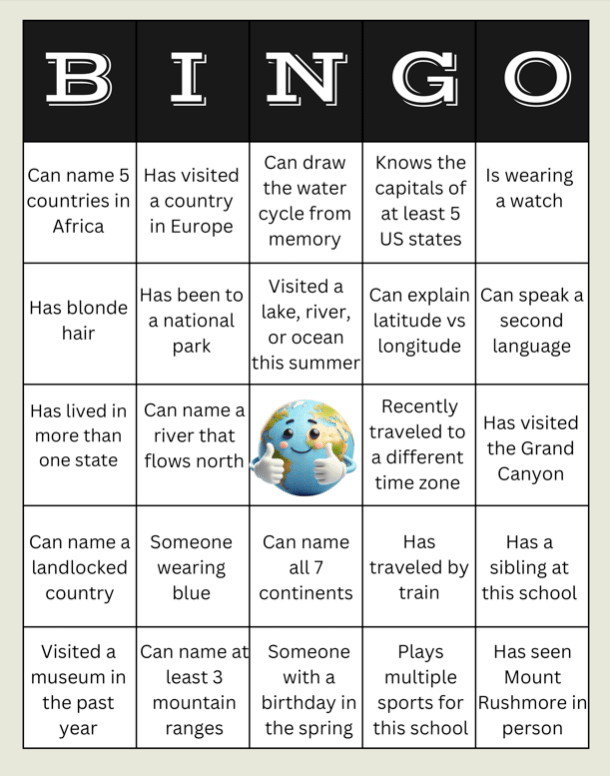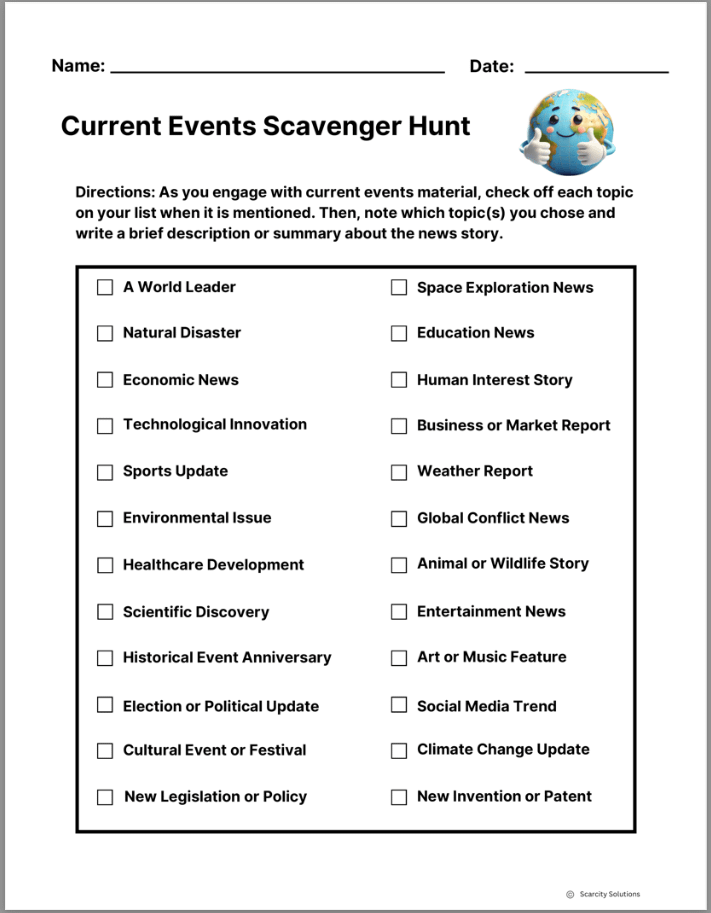New to AP Human Geography? Check out the first post in this series: AP Human Geography Made Simple: A Beginner’s Guide. It’s packed with tips for wrapping your head around the course itself — including what it actually is (spoiler: not a map quiz class), how to pace the year, and why it’s secretly one of the most fun classes to teach.
POV: You just found out you’re teaching AP Human Geography. You’ve got 30 students, zero materials, and no idea what “cultural landscape” means.
Let’s fix that.
Over the last 15 years, I’ve refined my go-to AP Human Geography first day activities into something that’s part icebreaker, part skill-builder, and part subtle indoctrination into the beautiful chaos of AP Human Geo.
Below are my go-to strategies — all of which are included in my free Unit 1 Activity Sampler, which you’ll definitely want to check out after you read this.
1. Icebreaker Bingo
They’ll roll their eyes at first, but once you get them up and moving — they’re in. I use a simple bingo card as way for students to interact. It has a geography vibe to it, but could really be used for any class.
Everyone gets the same card, so it’s not technically bingo. The object is to accomplish tasks (5 in a row). And they have to collaborate with other students to accomplish said task.
It makes for a great opening activity. Students are forced to move and talk, setting the tone for the rest of the year.
Plus, you learn a lot about your students fast. Who’s confident? Who’s quiet? Who can name two current world leaders?

2. Model the Bell-Ringer
Next, I introduce a daily routine that quietly trains students to think geographically — and sets the tone for how we start AP Human Geography class every single day.
You have many options for bell-ringers or warm-up type activities. Heck, you don’t even have to use one (although I highly recommend it–administrators love to seem them!).
You can use practice exam questions, a real world example that connects to the course, a quick quiz to review. However, my favorite way to begin each day is with the Question of the Day.
These aren’t trivia questions. They’re open-ended, Google-proof prompts (somewhat) that get students digging, wondering, and yes — sometimes arguing.
A good Question of the Day shouldn’t have a straightforward answer.
It should take some digging — maybe even some wild guessing.
The best ones are surprising, paradoxical, even backwards from what students assume.
Example: Who sells more diapers, Japan or the United States?
Students generally agree that United States sells more diapers because 1) the U.S. has more people and 2) more babies. (By the way, your job is to sell them the wrong answer. Really commit. Then — pull the rug out.)
“No, the answer is actually Japan.” And it’s not because they have more babies, but because they have such a high elderly population. They sell an incredible amount of adult diapers. Mind blown. Mission accomplished.
Here’s another example and one I like to use on the first day: Name the only two double-landlocked countries.
I like this one because it also allows some map skills practice. Give them each an atlas (if available). Teach them the difference between a political and physical map as they look for the answers.
The answer, by the way, is Liechtenstein and Uzbekistan. Let the confusion, discussion, and teaching moments unfold.
Students will usually find (eventually) Liechtenstein. But Uzbekistan is tricky and counterintuitive because you have to know a couple things about geography to confidently choose it. You have to know what “landlocked” actually means (and double-landlocked for that matter), and you have to know that the Caspian Sea isn’t actually a “sea”. It’s a lake.
Additionally, a really good Question of the Day can lead to great follow-up questions, like if Kazakhstan is technically landlocked, why do they have a navy? (Answer: to protect oil rights in the Caspian Sea).
The goal isn’t to get the “right” answer. (Spoiler: many will struggle. Some will try to Google it and blurt out the answer. Gently shut that down.)
It’s not about who answers first — it’s about building the habits AP Human Geography demands:
- Normalizing not knowing (yet)
- Thinking critically
- Asking better questions
- Practicing spatial reasoning
- Strengthening geography skills, day by day
I’ve included a year’s worth of these questions in the free Unit 1 Activity Sampler — each designed to spark curiosity, teach content, and build skills students actually retain.
Bonus tip: Have your Question of the Day posted at “Back to School Night” or “Meet the Teacher night”. It makes for a great conversation starter and you can remind them that when they ask at the dinner table, ‘What did you learn at school today?’ the student will always have an answer!
3. Current Events

Then we get real.
Every day (or most days), we’ll watch a short news video — usually CNN 10 with Coy Wire or The World from A to Z with Carl Azuz — and complete a Current Events Scavenger Hunt.
This isn’t about writing summaries or forming opinions on the news. It’s about pattern recognition. Relevance. Being awake to what’s going on around them.
Here’s how it works:
- Students check a box for each topic the story covers (world conflict, economy, etc.)
- They jot a short phrase describing the story
- (Optional) They write a one-sentence summary on the back
I usually just do the first two — it fits on one page, keeps things focused, and helps connect what’s happening out there to what we’re learning in here.
Even on Day 1, you can pause and explain as you go. Link stories to units. A story on food deserts? That’s Unit 5. A refugee crisis? That’s Unit 2. By the end of the year, they’ll be making those connections on their own.
And yep — the scavenger hunt worksheet is included in the Unit 1 Activity Pack.
4. World Geography Crossword Puzzles
This one’s straightforward.
It’s a simple crossword puzzle filled with world geography terms students should recognize — but many won’t. That’s the point. It’s review disguised as fun, and it surfaces gaps you’ll want to fill as the year goes on.
This also gives early finishers something productive to do while others are wrapping up.



5. Assign Countries
Depending on your pacing, this can be a Day 1 or Week 1 activity:
Have each student choose two countries — one developed, one less developed. These become their go-to examples all year long. FRQ practice? Country project? Final exam comparison? They’re using the same countries, deepening their understanding as they go.
It’s low-prep and sets up a through-line that gives students a personal anchor in the global scope of the course.
Pro tip: Let them choose from a curated list so there’s variety and balance across the class.
6. Hook Them with Humor
A few short videos go a long way to capture attention, spark thought, and set expectations. My opening day favorites:
- Shift Happens – for the “whoa, the world is changing” vibe
- Miss Teen South Carolina – as a humorous cautionary tale (we’re aiming higher)
- Lilly the Map Master – the antidote to Miss SC, and a model of real geographic thinking
You’ll have them laughing, then thinking. That’s the sweet spot.
7. Housekeeping
Every class has logistics. Just don’t let them hijack the first day!
- Go over expectations and routines
- Hand out textbooks
- Get them into Google Classroom, etc.
- Conduct and college student forms and/or surveys
Do what you need to do — but keep it short. The goal is to leave students thinking, “This class is going to be interesting,” not “This is just another syllabus slog.”
Final Thoughts of Encouragement
Your first day doesn’t need to be flawless — it just needs to plant the right seeds. These AP Human Geography first day activities help you build curiosity, normalize exploration, and kickstart the habits that will carry your class through May.
- Build curiosity
- Normalize exploration
- Connect course content to the real world
- Start building the habits and rituals that will carry your class through May
And please, don’t build it all from scratch.
I’ve created a free Unit 1 Activity Sampler that includes:
- Icebreaker Bingo
- A year of Questions of the Day
- The Current Events Scavenger Hunt
- Geography review crosswords
- And more ready-to-go tools to make your first days actually enjoyable
👉 [Grab your free Unit 1 Activity Sampler here]
You’ve got this. One question, one concept, one class period at a time.


2 Responses
[…] for more first day inspiration? Check out my complete guide on how to [Start Strong on the first day] for even more ways to succeed in AP Human […]
[…] results from day one. For even more ideas on launching your course successfully, check out our Start Strong: AP Human Geography First Day Activities […]